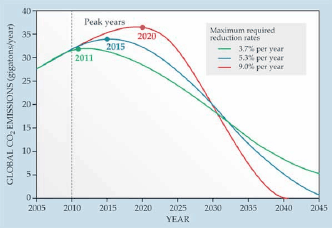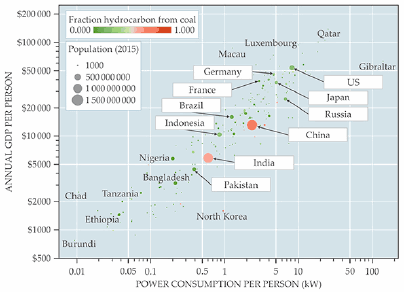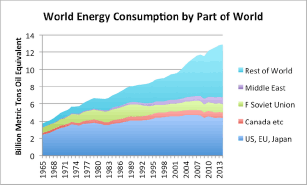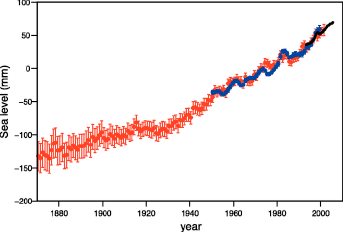Three Not Such Well-known Aspects of Solar Power and Climate Change
Wallace Manheimer
Retired from NRL
wallymanheimer@yahoo.com
This work was not sponsored by any agency pubic or private.
1. Introduction
The climate situation grabs more and more media attention these days. As this is written, there is a climate march occurring. This paper examines three not such well-known facts. First, one cannot turn on one’s TV these days without seeing that solar power (i.e. solar photovoltaic, solar thermal, wind and biofuel) is now cheaper and is rapidly overtaking fossil fuel as a power source for our civilization. This definitely is not true. Solar power is nowhere near a point where it makes an important contribution to the world’s power budget, and at this point at least, it is reasonable to surmise that it never will be. Second, one often reads that 97% of climate scientists agree that excess CO2 in the atmosphere is causing destructive climate change and that ‘the science is settled’. Neither is true. Third, the excess CO2 in the atmosphere has not done any significant environmental harm up to now, and extrapolating present data, it is unlikely to do so any time soon.
2. The Role of Solar Power
There are two important issues in the climate debate. The first is whether we need fossil fuel or can get along without it; i.e. can solar power move in and play the role any time soon? The second is whether the use of fossil fuel is causing or will cause a major environmental problem. A large part of the debate focuses only on the second issue and ignores the first.
Fossil fuel still produces about 85% of the world’s power. There is no denying this. Nevertheless, below is the Figure from Richard C. J. Somerville and Susan Joy Hassol’s article (Physics Today, October 2011) where they give various scenarios for ending the use of fossil fuel:
Clearly Somerville and Hassol insist that the use of fossil fuel must be greatly reduced in 20 years and must end soon thereafter. Other organizations such as the Sierra Club and 350.org, as well as Al Gore insist on ending the use of fossil fuel even sooner.

Figure 1: Various scenarios for ending the use of fossil fuel according to Somerville and Hassol. In all cases the use of fossil fuel must end in about 20 years.
How will we get the power we need? This is not a minor detail. Modern civilization depends critically on fossil fuel to power it. Without an abundant, inexpensive energy source, modern civilization simply vanishes. But they cannot be concerned with such trivia. They are too busy saving the planet; powering it without fossil fuel is someone else’s problem, it is not their department! It reminds one of the rhyme from the old Tom Lehrer song about Werner von Braun:
Once rockets go up, who cares where they come down? That’s not my department, says Werner von Braun!
To reiterate, doing what Somerville and Hassol, Al Gore, the Sierra Club… insist upon would end civilization unless another power supply, available at about the same quantity and price can replace fossil fuel. But as we will see shortly, solar power is nowhere near ready to do this.
We have to use fossil fuel responsibly, as cleanly and conservatively as possible, but use it we must. In a world with 7 or more billion people, it is directly or indirectly responsible for our prosperity, health, modern high tech medicine, longevity, education, transportation, the possibility of large cities, large scale international trade, a clean environment….. Those like 350.org and other like-minded groups and individuals wrongly think that civilization can thrive without it. But the truth is that without it, it is back to abject poverty for all but the privileged few, as has been humanity’s fate for almost its entire existence, i.e when fossil fuel was not used.
Hence almost the entire moral argument is on the side of using fossil fuel, especially for the developing world. For instance in the July 2016 Issue of Physics Today, in an article: Physics, fracking, fuel, and the future, by Michael Marder, Tadeusz Patzek and Scott W. Tinker, presented a graph, demonstrating the unbreakable link between fossil fuel use and prosperity, shown in Figure 2, along with its caption.

Figure 2: The plot from Marder et al and its caption: Figure 1. The correlation between hydrocarbon-based power consumption and economic output for most countries on Earth. A power-law fit finds that annual GDP per person is G = $10 500 (C/kW)0.64, where C is hydrocarbon-based energy consumption per second per person. The tight power-law relationship indicates that economic prosperity is not currently feasible without consumption of hydrocarbon fuels. The power law is reminiscent of scaling laws in biology; 15 the flow of petroleum through economies resembles the flow of blood in mammals. On average, the hydrocarbon power consumed in the US is 8 kW per person, the same as 80 incandescent 100 W bulbs burning continuously. If the US were to rely only on its currently available renewables — biomass cogeneration, wood, hydropower, geothermal, wind, passive solar, and photovoltaics — power consumption would drop to four bulbs per person; eliminating hydropower and biofuels would reduce the number to one or two. The reduction would entail such a change in lifestyle as to make the US unrecognizable. 16 (Data source: Central Intelligence Agency, World Factbook, 2015; DOE/Energy Information Administration, 2015.)
Citation: Phys. Today 69, 7, 46 (2016); http://dx.doi.org/10.1063/PT.3.3236
Roughly a billion people in the US, Europe, Russia and Japan each use about 6 kW (i.e. 6 terawatts total), leaving about 1 kW for each of the other 6 billion people on the planet. Notice that according to the chart, the average Chinese uses about 25% of the power of the average American. In 2000, this figure was about 10%. In 2009 I was at a scientific meeting, where a high ranking member of the Chinese Academy of Science remarked on this, and said that they would not rest until their per capita power use is about the same as ours. They know that there is an unbreakable link between power and prosperity.
What is important is that fossil fuel cannot and will not be eliminated until another power source, becomes available at about the same quantity and price. The Chinese, Indians, Brazilians, Mexicans, Indonesians, Nigerians, … understand this unbreakable link between fossil fuel and prosperity, no not just prosperity, human civilization; even if we do not. They are sick of poverty, and who are we to blame them. Who are we to condemn them for escaping poverty the only way anyone knows how to do so; namely by using fossil fuels.
To illustrate how unlikely it is that renewable solar power can play any role in the world energy budget anytime soon, and the fact that the less developed world will not heed our advice to move away from fossil fuel, consider the Figs (3 and 4), taken from the BP statistical review of world energy 2013. Clearly renewables have a long, long way to go before they can supplant fossil fuel. Also it is the less developed parts of the world that are increasing the use of fossil fuel. The use of fossil fuel by the more developed parts of the world has leveled off.

Figure 3: Clearly it is extremely unlikely that solar power can replace fossil fuel in 20 years as Somerville and Hassol, and many others insist. Simply ending fossil fuel without a replacement would impoverish the world and set civilization back centuries.https://ourfiniteworld.com/2015/06/23/bp-data-suggests-we-are-reaching-peak-energy-demand

Figure 4: It is the less developed parts of the world that are increasing energy use as they struggle to end their persistent poverty.
https://ourfiniteworld.com/2015/06/23/bp-data-suggests-we-are-reaching-peak-energy-demand
A major effort has been made to support renewable solar power. It has been heavily subsidized for at least a quarter of a century. The American Federal support for climate change research over the past 20 years is shown in Figure (5) below. It was ~$12B in 2014. The average over this period was ~$7B per year, meaning that ~$140B has been spent on climate change research over the past 20 years! For this we got the amount of solar power affecting the world economy as shown in Fig (3)
Some have argued that fossil fuel receives larger federal subsidies than renewables. While every industry, including fossil fuel, gets a variety of tax breaks (eg. business expenses, depreciation, …), fossil fuel receives far less in direct subsidies than solar power. The American Energy Information Agency publishes data on federal support for various energy options. Their chart is in Figure (6). Renewable power is subsidized about $15B (a bit more than Fig. (5) indicates), and fossil fuel about $3B. However since renewable power only produces ~1% of the world’s power, it gets about 500 times as much subsidy per energy unit produced. Furthermore, fossil fuel pays taxes, as anyone driving up to a gas station to fill his or her tank knows.
Reported Federal Climate Change Funding by Category, 1993-2014
An enormous effort has been made to bring up solar power to a point where it can contribute to the world economy; clearly it has failed at this point.

Figure 5: Since 1993 the Federal government has spent ~$140B on climate change funding. http://www.gao.gov/key_issues/
climate_change_funding_management/
issue_summary

Figure 6: It is solar, wind, biofuels that received the lion’s share of subsidies. https://www.eia.gov/todayinenergy/detail.php?id=20352
3. The ‘97%’ scientific consensus
Another question is whether 97% of climate scientists really believe that fossil fuel is causing, or will cause great environmental damage. One interesting piece of data is the Oregon Petition. This was an effort led by Frederick Seitz (deceased), a former president of the National Academy of Science. It is a petition disputing the effect of humans on global warming. It garnered 32,000 signatures by a large cross section of the scientific community. Here is a link to it (http://www.petitionproject.org). As would be needed to justify the 97% figure, are there really a million scientists who have signed an opposing petition?
A recent op-ed in the Wall Street Journal by Steven Koonin, April 17, 2017, sheds further light. In the op-ed he proposed that a red and blue team of scientist separately evaluate the issue. He goes on to state:
“The public is largely unaware of the intense debates within climate science. At a recent national laboratory meeting, I observed more than 100 active government and university researchers challenge one another as they strove to separate human impacts from the climate’s natural variability. At issue were not nuances but fundamental aspects of our understanding, such as the apparent — and unexpected — slowing of global sea level rise over the past two decades.”
So much for the ‘97%’ and “the science is settled”.

Figure 7: a plot of ocean rise. The rise has been at a rate of 20-25 cm/century since about 1920, with no recent increase. https://www.ipcc.ch/publications_and_data/
ar4/wg1/en/figure-5-13.html
4. CO2 has had little or no effect on the environment so far.
The next issue is whether CO2 is now doing harm to the environment. Before considering this, let us consider a couple of simple, obvious facts about CO2. It is not a pollutant, but rather a vital nutrient for plants. Over many of the hundreds of millions of years when plant and animal life was evolving, CO2 levels were much higher than today. While humans did not exist during this time, our primate ancestors did fine. Every carbon atom in our bodies, and in the food we eat; had its origin in the carbon in plants and decayed organic matter in the soil; which in turn had its origin in the CO2 in the atmosphere and in the oceans. There is even evidence that the added CO2 in the atmosphere since the dawn of the industrial age has aided agriculture and has helped in greening the planet (http://co2coalition.org). Without atmospheric CO2, life on earth would not be possible.
But is the added amount since the start of the industrial age doing any harm? This author has examined assertions of a variety of important people, President Obama, Hillary Clinton, Marcia McNutt (the editor of Science Magazine), Al Gore…. All have made specific claims of imminent doom (eg. more frequent and intense storms, loss of agricultural productivity, rising sea levels…) if we continue to burn fossil fuel at current or projected rates. But how can the average person, or even the average scientist independently check this out? Is the only choice to read thousands of journal articles in dusty, obscure journals, journals to which the average person has no access?
Fortunately there is another way. A great deal of data is available on line with simple a Google or Google images search. This is something anyone can do, anywhere, anytime. There is no need for any expert to interpret the data; it speaks for itself. However there are possible pitfalls to a Google type search, which one must be cognizant of. After all, one could undoubtedly find a miracle cure for cancer by doing a Google search. But generally this is no big deal; it is easy to avoid this sort of trap. I am quite certain there are no significant errors in the data I presented.
This work is summarized in
Wallace Manheimer, Original Sin, Prophets, Witches, Communists, Preschool Sex Abuse and Climate Change, International Journal of Advanced Research, June 2016, page 280
Journal web site: www.journalijar.com
http://www.journalijar.com/article/9945/original-sin,-prophets,-witches,-communists,-preschool-sex-abuse-and-climate-change/ which is available open access.
In a nutshell, the conclusion of this data search, which anyone can easily check up on, is that claims of impending doom are, for the most part either wildly exaggerated, or else are continuations of processes which have been occurring nearly unchanged for centuries. Not a single one of the specific assertions of gloom and doom mentioned can stand up to serious scrutiny. To this author’s mind, it is amazing that the mainstream media does not do such a careful check up on the data it is spoon fed by alarmists. Any competent science reporter for any major media outlet could easily do what I did and almost certainly come to the same conclusion. My guess is that the media’s inability and unwillingness to do such a check will ultimately harm its reputation for decades to come.
Very briefly summarizing, the article shows that NOAA’s ground based measurements of temperature had recently changed so as to find recent warming in contrast to their earlier measurements which showed a nearly 20 year hiatus in warming. I believe NOAA has seriously damaged its credibility by publishing such changes, changes that please their political bosses; and then refusing to publicize their new methodology. My article also shows that NASA’s space based temperature measurement give rather different results, results that show less warming, but a temperature which oscillates in time with a variety of frequencies. The article shows that there has been no increase in hurricanes, tornados, wild fires, droughts or loss of agricultural productivity. Furthermore it shows that the retreat of glaciers is a 200-year phenomenon, one showing no increase as atmospheric CO2 increases. Also it points out that NASA’s most recent satellite measurements show ice sheets in Antarctica thickening, not melting (that is the difference between the ice thickening in some places, and the melting in others is positive). The article points out the German experience, which indicates that at least up to now, solar power is considerably more expensive than the alternatives and using it does not necessarily reduce CO2 input to the atmosphere. Regarding numerical simulations of climate, it shows that they have greatly overestimated the heating. As I mentioned these are conclusions anyone can check out anywhere, anytime. The data speaks for itself, it needs no expert to interpret it. I believe that is the main strength of my paper.
As a single illustration, the rate of sea level rise can be obtained by simple doing a search on Google images of ‘Graph of sea level rise’. Many graphs will pop up, all about the same; they all show that the seas have been rising at a rate of about 20-25 cm/century for decades, with no particular recent increase. In Figure (7) is one such graph based on IPCC data.
Some might think my paper has an odd sounding name. The reason is that it also makes the case that those I call alarmists are rather like old testament prophets, accusing mankind of sin, and courting severe punishment, a sin and punishment which only they can discern. They say that we must either change our ways or be destroyed. However unlike their biblical predecessors, these modern day ‘prophets’ have no direct pipeline to God. The paper compares the climate change alarmists to other such ‘prophets’ the title suggests, ‘prophets’ who caused general or localized panics and created only harm and chaos in their wake. Obviously this is not a scientific argument, but any reader can judge for himself whether the comparison makes any sense. To me it does.
5. Conclusion
Since solar power is so far from becoming an important player in the world energy budget, and since the scientific community is far from united on whether excess CO2 in the atmosphere will have a significant environmental effect, and since it almost certainly has had no such effect so far, the question is should we be on a breakneck pace to reduce fossil fuel use in the hope that solar power can replace it? This author’s answer is no. The cost to civilization would be astronomical if solar power should fail, as it has so far.
These contributions have not been peer-refereed. They represent solely the view(s) of the author(s) and not necessarily the view of APS.
